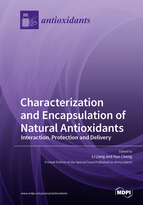Characterization and Encapsulation of Natural Antioxidants: Interaction, Protection and Delivery
A special issue of Antioxidants (ISSN 2076-3921). This special issue belongs to the section "Extraction and Industrial Applications of Antioxidants".
Deadline for manuscript submissions: closed (15 February 2022) | Viewed by 59485
Special Issue Editors
2. School of Food Science and Technology, Jiangnan University, Wuxi 214122, China
Interests: bioactive compounds; proteins; polysaccharides; structure–function relationship; delivery system; co-encapsulation; biological activity; food additives; funcitonal foods
Special Issues, Collections and Topics in MDPI journals
2. School of Food Science and Technology, Jiangnan University, Wuxi 214122, China
Interests: bioactive components; proteins; polysaccharides; synergism; biopolymer-based delivery system; in vitro digestion; functional additives and foods
Special Issue Information
Dear Colleagues,
Natural antioxidants, such as polyphenols, carotenoids, vitamins, polyunsaturated fatty acids, peptides, and enzymes, are expected to inhibit oxidative damage of proteins and lipids in food systems and reduce the risk of certain chronic diseases related to oxidative stress. Their antioxidant activity is dependent on structure and concentration and is sensitive to environmental conditions. Additionally, combinations of diverse antioxidants (e.g., crude extracts) may work synergistically to exert enhanced chemical stability and biological activity. Therefore, natural antioxidants are a good source of nutraceuticals for application in functional foods and additives. However, most natural antioxidants have poor aqueous solubility, high sensitivity to processing and storage conditions, and low bioavailability, which restricts their incorporation into many food systems and health benefits.
Biopolymers, such as proteins, polysaccharides, and lipids, are edible carriers for antioxidants. Many of their structural and physicochemical properties facilitate the design and fabrication of edible delivery systems, which can overcome the limitations of natural antioxidants used in food and pharmaceutical industries. In general, an edible delivery system should have a high payload of antioxidants, be compatible with a product matrix, improve the physical and chemical stability of antioxidants, and show a controlled release profile in response to specific changes in environmental conditions. Additionally, co-delivery systems have gained significant interest because they can simultaneously and efficiently deliver different compounds to produce synergistic effects in the treatment of certain diseases. Although a wide range of antioxidants have been encapsulated into edible carriers, the mechanisms underlying the impact of encapsulation on antioxidant activity and antioxidant–material interactions remain limited. Therefore, novel delivery designs and new technologies can be brought into conventional administration approaches to expand applications of natural antioxidants in food and pharmaceutical fields.
We invite you to submit your latest research findings or review articles to this Special Issue, which will bring together current research concerning the mechanisms of antioxidant–antioxidant and antioxidant–material interactions; the encapsulation, protection, and delivery of a single antioxidant or a mixture of diverse antioxidants; and the evaluation of encapsulated antioxidants in in vitro and in vivo models.
Prof. Dr. Li Liang
Dr. Hao Cheng
Guest Editors
Manuscript Submission Information
Manuscripts should be submitted online at www.mdpi.com by registering and logging in to this website. Once you are registered, click here to go to the submission form. Manuscripts can be submitted until the deadline. All submissions that pass pre-check are peer-reviewed. Accepted papers will be published continuously in the journal (as soon as accepted) and will be listed together on the special issue website. Research articles, review articles as well as short communications are invited. For planned papers, a title and short abstract (about 100 words) can be sent to the Editorial Office for announcement on this website.
Submitted manuscripts should not have been published previously, nor be under consideration for publication elsewhere (except conference proceedings papers). All manuscripts are thoroughly refereed through a single-blind peer-review process. A guide for authors and other relevant information for submission of manuscripts is available on the Instructions for Authors page. Antioxidants is an international peer-reviewed open access monthly journal published by MDPI.
Please visit the Instructions for Authors page before submitting a manuscript. The Article Processing Charge (APC) for publication in this open access journal is 2900 CHF (Swiss Francs). Submitted papers should be well formatted and use good English. Authors may use MDPI's English editing service prior to publication or during author revisions.
Keywords
- Antioxidant
- Characterization
- Interaction
- Encapsulation
- Protection
- Controlled release
- Bioaccessibility/bioavailability
- Functional additives
- Functional foods.








